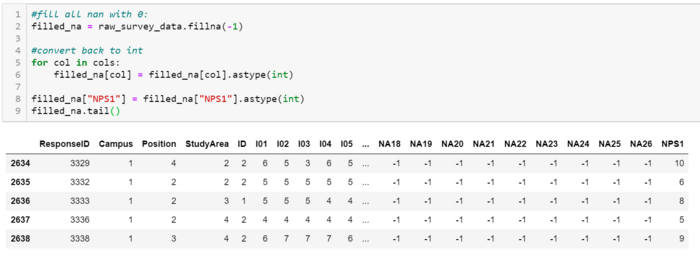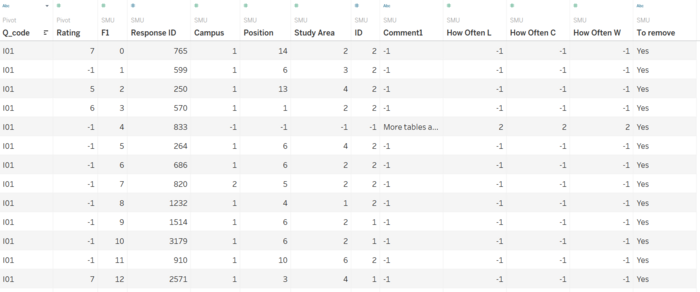Difference between revisions of "IS428 AY2019-20T2 Assign LIM SI LING"
| Line 78: | Line 78: | ||
| Lastly, the survey questions have to be mapped to the question code. | | Lastly, the survey questions have to be mapped to the question code. | ||
<br>This was done by dragging the Legend Sheet right next to SMU and join them by left outer join, keeping all the data rows in SMU. The two sheets are joint by their question code (Q_code in SMU and Code in Legend). | <br>This was done by dragging the Legend Sheet right next to SMU and join them by left outer join, keeping all the data rows in SMU. The two sheets are joint by their question code (Q_code in SMU and Code in Legend). | ||
| + | |} | ||
| + | |||
| + | <br>On top of the data preparation above, the survey questions can be split into the following categories to better identify the areas of improvement for SMU Libraries: | ||
| + | {| class="wikitable" width="100%" | ||
| + | |- | ||
| + | ! style="font-weight: bold;background: #57546E;color:#fbfcfd;width: 33%" | Category | ||
| + | ! style="font-weight: bold;background: #57546E;color:#fbfcfd;" | Survey Questions | ||
| + | |- | ||
| + | |Overall Satisfaction | ||
| + | |27: Overall how satisfied are you with the Library? | ||
| + | |- | ||
| + | |Library Resources | ||
| + | | | ||
| + | 11: The items I'm looking for on the library shelves are usually there | ||
| + | <br>20: Information resources located in the Library (e.g. books, journals, DVDs) meet my learning and research needs | ||
| + | <br>21: Online resources (e.g. online articles, databases, ebooks) are useful for my studies and help me with my learning and research needs | ||
| + | <br>22: Course specific resources (online and in the reserve collection) meet my learning needs | ||
| + | <br>25: Access to Library information resources has helped me to be successful at university | ||
| + | |- | ||
| + | |Facilities | ||
| + | | | ||
| + | 14: I can find a quiet place in the Library to study when I need to | ||
| + | <br>15: I can find a place in the Library to work in a group when I need to | ||
| + | <br>16: A computer is available when I need one | ||
| + | <br>17: Laptop facilities (e.g. desks, power) in the Library meet my needs | ||
| + | <br>18: I can get wireless access in the Library when I need to | ||
| + | <br>19: Printing, scanning and photocopying facilities in the Library meet my needs | ||
| + | |- | ||
| + | |Services Provided | ||
| + | | | ||
| + | 01: I am informed about the Library services | ||
| + | <br>02: The Library website provides useful information | ||
| + | <br>03: Library signage is clear | ||
| + | <br>04: Library workshops, classes and tutorials help me with my learning and research needs | ||
| + | <br>05: The Library anticipates my learning and research needs | ||
| + | <br>06: Opening hours meet my needs | ||
| + | <br>07: Books and articles I have requested from other Libraries are delivered promptly | ||
| + | <br>08: Self Service (e.g. self-check loans, requests, renewals, holds) meets my needs | ||
| + | <br>09: Online enquiry services (e.g. Email, Library Chat) meet my needs | ||
| + | <br>10: Face-to-face enquiry services meet my needs | ||
| + | <br>12: Library staff provide accurate answers to my enquiries | ||
| + | <br>13: I can get help from library staff when I need it | ||
| + | <br>23: When I am away from campus I can access the Library resources and services I need | ||
| + | <br>24: The Library search engine enables me find relevant library resources quickly | ||
| + | <br>26: I find it easy to use mobile devices (e.g. tablets and phones) to access online resources | ||
|} | |} | ||
Revision as of 00:12, 15 March 2020
Overview
Every two years, SMU Libraries conduct a comprehensive survey in which faculty, students and staff can rate various aspects of SMU library's services. The survey results are an important feedback for SMU libraries to understand the quality of their services and facilities and identify key areas that needs improvement to better meet the needs of their users.
Objectives
I am tasked by SMU libraries to use visual analytics approach to reveal the level of services provided by them as perceived by:
- the undergraduate students
- the postgraduate students
- the faculty
- the staff
There was previously a report (Library Survey Report) generated. However, it consists of many separated graphs and charts which is too disjointed to be read properly. Additionally, the report incorrectly uses Mean as a measure. The survey questions are graded based on a 7 point Likert scale. The mean in a Likert scale can't be found because it is not possible to find an average of “agree”, “disagree”, and “neutral. Therefore, the goal is to produce a visualisation of the survey results by reducing the number of charts and providing dashboards to highlight performance of SMU libraries in terms of overall satisfaction, facilities, resources and services provided.
Survey Data
Description of Data
The survey data provided is a single excel workbook containing two sheets:
| Sheetname | Description |
|---|---|
| SMU | The raw survey results containing survey respondents and each of their reply to the survey questions in the form of ratings.
The raw survey results have a total of 2639 rows or number of participants. There are a total of 89 column. However, there are missing data as well that needed to be removed. The attributes of the data can be divided into the following:
|
| Legend | The legend that contains the exact survey questions and the question code that they represent. |
Data Preparation
The data collected from the survey had many missing values apart from those who have picked N/A for the question. Therefore, data with key areas missing are to be excluded from the data visualisation since they were no longer useful in providing insights.
To remove missing data, codes were written in python to determine which rows to remove.
| Screenshot | Action taken and description |
|---|---|
| The excel workbook "Raw data 2018-03-07 SMU LCS data file - KLG.xlsx" is imported into jupyter notebook. | |
| To make it easier to deal with the data, cells that are empty are filled with -1 as their values | |
| |
Next, the criteria for which data to be removed is determined as follows:
|
| Legend is copied over to the newly exported dataset. | |
| The new excel workbook is then imported into Tableau. | |
| However, the dataset cannot be used directly, as the question codes are not linked to the actual question itself. Pivoting of the data set is required.
| |
| Lastly, the survey questions have to be mapped to the question code.
|
On top of the data preparation above, the survey questions can be split into the following categories to better identify the areas of improvement for SMU Libraries:
| Category | Survey Questions |
|---|---|
| Overall Satisfaction | 27: Overall how satisfied are you with the Library? |
| Library Resources |
11: The items I'm looking for on the library shelves are usually there
|
| Facilities |
14: I can find a quiet place in the Library to study when I need to
|
| Services Provided |
01: I am informed about the Library services
|







